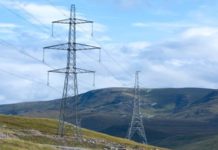National Grid’s report into the 9 August blackout has shed further light on the causes of the frequency drop.
The electricity system operator has also recommended:
- A review to determine if it is worth beefing up security of supply standards (which if implemented may require procuring more frequency response)
- Potentially expediting plans to change of loss of mains protection for embedded generators so that they do not trip as easily
- Reviewing who gets automatically disconnected from the distribution network
- Assessing whether critical infrastructure providers should have a standard their internal systems should be designed to handle
The review provides more detail on the sequence of events that led Hornsea offshore wind farm, Little Barford CCGT and swathes of distributed generators to trip.
It confirms National Grid ESO had sufficient reserve power to react to a frequency loss equivalent to the largest single infeed loss, and was managing to restore frequency after the initial trips at Hornsea, Little Barford and distributed generation when a second unit at Little Barford tripped. At that point there was not enough frequency response left and frequency dropped to 48.8Hz, resulting in around 1GW of demand disconnection to keep the rest of the system running.
Citing Ørsted’s incident report, the ESO states that the configuration of Hornsea’s network was a “contributory factor” to its deloading and that its turbine controllers “reacted incorrectly”. Ørsted has since updated its systems.
RWE’s report is less conclusive. The firm continues to investigate the conditions under which its steam turbine initially tripped and why “for reasons presently unknown” its first gas turbine tripped a minute later. The second gas turbine was manually shut down due to high steam pressure. RWE has planned a shutdown this month and will investigate further.
See the report here.
Colm Murphy, of National Grid ESO, will speak at The Energyst’s DSR Event, taking place tomorrow at One Moorgate Place. Details here.
Related stories:
National Grid: two generators cause big frequency drop
Blackouts: what happened and what are the implications?
Reactive Technologies signs deal with ESO to measure inertia
National Grid uses more Stor and frequency response, flags challenges ahead
National Grid and Epex Spot to collaborate on weekly FFR auction
National Grid to trial same day FFR auction
Grid to bring wind and solar into FFR, details balancing system overhaul
Can the Balancing Mechanism offset FFR price erosion?
Grid outlines plans to bring all flex providers into Balancing Mechanism
Grid outlines plans for hundreds of millions worth of services
Grid plots major overhaul of balancing services with frequency response first to change
National Grid mulls rolling all frequency response services into one
Faraday Grid: We come from the future to stabilise the power system
Click here to see if you qualify for a free subscription to the print magazine, or to renew.
Follow us at @EnergystMedia. For regular bulletins, sign up for the free newsletter.




I spoke with someone from National Grid about the need for National Grid to have live Health and Weather Indicators of all generating assets attached, or capable of attaching to, the grid. They did not appear to get the importance of doing so, and here we are.